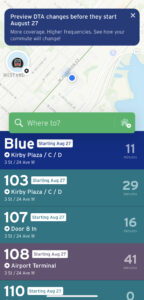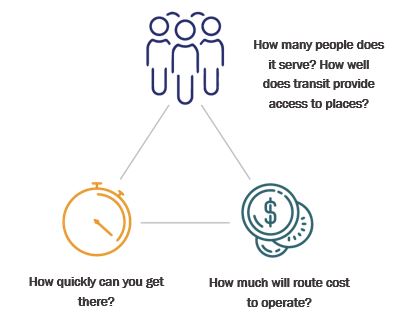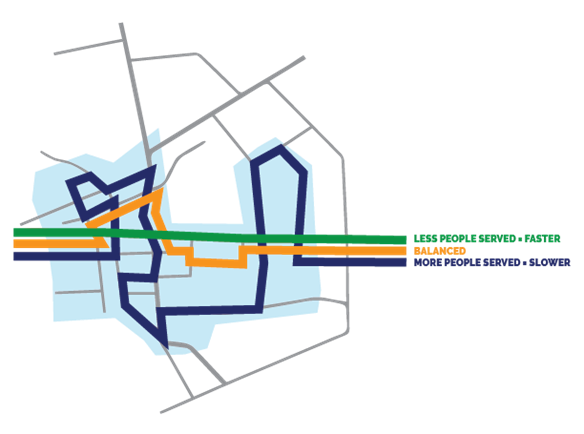
Keep tabs on all of the exciting DTA initiatives!
The Better Bus Blueprint is HERE!
Using the content below, passengers can expect video route previews, time tables, and maps for each of the new routes. The system serves more passengers, connects key activities centers more efficiently, and offers two high-frequency Go-Line routes. The Go lines have uniquely branded buses, more buses per hour, and serve as pillars of the network.
We have refreshed the brand, and will have new signage at over 700 bus stops, clearly distinguishing the high frequency go-line stops from our local traditional service. Dedicated buses with new graphics will specifically serve these go line routes as well. Additionally, each bus stop is or will be equipped with a “Where’s my Bus” tool, where passengers can call or text with the Stop ID to quicky track approaching buses. This tool is especially useful for those less familiar with the new system, and during times of unpleasant weather.
This new system is a culmination of partnerships with community stakeholders, expert consultants, and large sets of data. We are very excited to match the contemporary needs and travel patterns of the community with a bus service that lines up with what is needed. Simplified routing, consistent weekend route times, and higher frequencies are the ingredients to get more folks where they want to be.
CLICK HERE FOR AN INTERACTIVE MAP TO FIND YOUR NEW BUS STOP
 Looking for another way to preview the Better Bus Blueprint system? If you have the Transit App, there is now a button to toggle onto a system preview for the new system. If you don’t already have our FREE Transit App (downloadable on Apple Play and Android App Store) now is the perfect time to grab the App and plan your trips!
Looking for another way to preview the Better Bus Blueprint system? If you have the Transit App, there is now a button to toggle onto a system preview for the new system. If you don’t already have our FREE Transit App (downloadable on Apple Play and Android App Store) now is the perfect time to grab the App and plan your trips!
Blue Line
.embed-container { position: relative; padding-bottom: 56.25%; height: 0; overflow: hidden; max-width: 100%; } .embed-container iframe, .embed-container object, .embed-container embed { position: absolute; top: 0; left: 0; width: 100%; height: 100%; }
Green Line
.embed-container { position: relative; padding-bottom: 56.25%; height: 0; overflow: hidden; max-width: 100%; } .embed-container iframe, .embed-container object, .embed-container embed { position: absolute; top: 0; left: 0; width: 100%; height: 100%; }
.embed-container { position: relative; padding-bottom: 56.25%; height: 0; overflow: hidden; max-width: 100%; } .embed-container iframe, .embed-container object, .embed-container embed { position: absolute; top: 0; left: 0; width: 100%; height: 100%; }
Route 103: New Duluth-DTC-Lakeside-UMD
.embed-container { position: relative; padding-bottom: 56.25%; height: 0; overflow: hidden; max-width: 100%; } .embed-container iframe, .embed-container object, .embed-container embed { position: absolute; top: 0; left: 0; width: 100%; height: 100%; }
.embed-container { position: relative; padding-bottom: 56.25%; height: 0; overflow: hidden; max-width: 100%; } .embed-container iframe, .embed-container object, .embed-container embed { position: absolute; top: 0; left: 0; width: 100%; height: 100%; }
Route 104: East 4th Street
.embed-container { position: relative; padding-bottom: 56.25%; height: 0; overflow: hidden; max-width: 100%; } .embed-container iframe, .embed-container object, .embed-container embed { position: absolute; top: 0; left: 0; width: 100%; height: 100%; }
.embed-container { position: relative; padding-bottom: 56.25%; height: 0; overflow: hidden; max-width: 100%; } .embed-container iframe, .embed-container object, .embed-container embed { position: absolute; top: 0; left: 0; width: 100%; height: 100%; }

Route 105: East 9th Street
.embed-container { position: relative; padding-bottom: 56.25%; height: 0; overflow: hidden; max-width: 100%; } .embed-container iframe, .embed-container object, .embed-container embed { position: absolute; top: 0; left: 0; width: 100%; height: 100%; }
.embed-container { position: relative; padding-bottom: 56.25%; height: 0; overflow: hidden; max-width: 100%; } .embed-container iframe, .embed-container object, .embed-container embed { position: absolute; top: 0; left: 0; width: 100%; height: 100%; }
Route 106: Kenwood
.embed-container { position: relative; padding-bottom: 56.25%; height: 0; overflow: hidden; max-width: 100%; } .embed-container iframe, .embed-container object, .embed-container embed { position: absolute; top: 0; left: 0; width: 100%; height: 100%; }
.embed-container { position: relative; padding-bottom: 56.25%; height: 0; overflow: hidden; max-width: 100%; } .embed-container iframe, .embed-container object, .embed-container embed { position: absolute; top: 0; left: 0; width: 100%; height: 100%; }
Route 107: LSC-Trinity-Mall
.embed-container { position: relative; padding-bottom: 56.25%; height: 0; overflow: hidden; max-width: 100%; } .embed-container iframe, .embed-container object, .embed-container embed { position: absolute; top: 0; left: 0; width: 100%; height: 100%; }
.embed-container { position: relative; padding-bottom: 56.25%; height: 0; overflow: hidden; max-width: 100%; } .embed-container iframe, .embed-container object, .embed-container embed { position: absolute; top: 0; left: 0; width: 100%; height: 100%; }
Route 108: 24th-Piedmont-Hermantown
.embed-container { position: relative; padding-bottom: 56.25%; height: 0; overflow: hidden; max-width: 100%; } .embed-container iframe, .embed-container object, .embed-container embed { position: absolute; top: 0; left: 0; width: 100%; height: 100%; }
.embed-container { position: relative; padding-bottom: 56.25%; height: 0; overflow: hidden; max-width: 100%; } .embed-container iframe, .embed-container object, .embed-container embed { position: absolute; top: 0; left: 0; width: 100%; height: 100%; }

Route 109: Proctor-Spirit Valley-DTC
.embed-container { position: relative; padding-bottom: 56.25%; height: 0; overflow: hidden; max-width: 100%; } .embed-container iframe, .embed-container object, .embed-container embed { position: absolute; top: 0; left: 0; width: 100%; height: 100%; }
.embed-container { position: relative; padding-bottom: 56.25%; height: 0; overflow: hidden; max-width: 100%; } .embed-container iframe, .embed-container object, .embed-container embed { position: absolute; top: 0; left: 0; width: 100%; height: 100%; }


Route 110: DTC-Superior Tower Avenue
.embed-container { position: relative; padding-bottom: 56.25%; height: 0; overflow: hidden; max-width: 100%; } .embed-container iframe, .embed-container object, .embed-container embed { position: absolute; top: 0; left: 0; width: 100%; height: 100%; }
.embed-container { position: relative; padding-bottom: 56.25%; height: 0; overflow: hidden; max-width: 100%; } .embed-container iframe, .embed-container object, .embed-container embed { position: absolute; top: 0; left: 0; width: 100%; height: 100%; }

Route 111: Superior Circulator
.embed-container { position: relative; padding-bottom: 56.25%; height: 0; overflow: hidden; max-width: 100%; } .embed-container iframe, .embed-container object, .embed-container embed { position: absolute; top: 0; left: 0; width: 100%; height: 100%; }
.embed-container { position: relative; padding-bottom: 56.25%; height: 0; overflow: hidden; max-width: 100%; } .embed-container iframe, .embed-container object, .embed-container embed { position: absolute; top: 0; left: 0; width: 100%; height: 100%; }
Route 112: Woodland-UMD-Mall
Route 113: Park Point
.embed-container { position: relative; padding-bottom: 56.25%; height: 0; overflow: hidden; max-width: 100%; } .embed-container iframe, .embed-container object, .embed-container embed { position: absolute; top: 0; left: 0; width: 100%; height: 100%; }
.embed-container { position: relative; padding-bottom: 56.25%; height: 0; overflow: hidden; max-width: 100%; } .embed-container iframe, .embed-container object, .embed-container embed { position: absolute; top: 0; left: 0; width: 100%; height: 100%; }

Route 114: Central Hillside-Observation Hill Circulator
.embed-container { position: relative; padding-bottom: 56.25%; height: 0; overflow: hidden; max-width: 100%; } .embed-container iframe, .embed-container object, .embed-container embed { position: absolute; top: 0; left: 0; width: 100%; height: 100%; }

About
Why did the DTA conduct this study?
In 2017, the DTA completed a Transit Development Plan. In that plan, the DTA heard loud and clear that the community wanted to see service improvements by running buses more frequently and making the system less complicated. Phase 2 of that plan suggested the DTA focus on efficiency and add in more frequent service. Due to the complexity of a bus network, it required significant work to re-align it to fit the needs of the community.
Generally, the DTA network goes to the same places as it did five, ten, or 100 years ago. And most of those places are just as important now as they were then. People change their behavior over time, including where they live, work, and relax. The region has also seen new developments, housing, and employment centers. The Better Bus Blueprint will incorporate proven system planning principles, demographic and economic data, historical ridership trends, review travel patterns, and community input to make a recommendation for a revised DTA network and schedule.
The Basics of Route Planning
The Cost of Operating a Route
The cost of a bus route typically includes three things:
- The cost of the driver to operate the bus.
- The maintenance cost (including mechanics, janitors, and materials and supplies) to make sure the vehicle is in good working order.
- The administrative cost (including the managers, accountants, lawyers, and marketing) to manage DTA.
By far the largest share of the three items is the cost of the driver. Each route requires a certain number of drivers, based on the length of the route and how frequent it is (in other words, how often the bus comes). A route to Proctor operating every 10 minutes will require more drivers than a short downtown circulator that comes once an hour.
What Goes Into Route Planning?
The challenge with route planning is that the DTA’s budget is limited. If we had the funds, we would operate many routes as frequently as possible so that riding the bus would be easy and simple. Instead, we must make choices to meet our budget while maximizing the service benefit. This means we must pick where the routes go, how frequent they come, and when they operate.
We typically consider the following five factors when we plan a route:
 How often will the bus come? Frequent buses reduce waiting time, makes connections easier, and helps make the bus a more reliable transportation option. A frequent bus (coming every 10 minutes) is easier to use because you do not have to check a schedule and wait times are short. A less frequent bus (every 30-60 minutes) increases the wait time or requires you to check a schedule before making your trip. Missing a bus when it is infrequent can be very unpleasant and sometimes consequential.
How often will the bus come? Frequent buses reduce waiting time, makes connections easier, and helps make the bus a more reliable transportation option. A frequent bus (coming every 10 minutes) is easier to use because you do not have to check a schedule and wait times are short. A less frequent bus (every 30-60 minutes) increases the wait time or requires you to check a schedule before making your trip. Missing a bus when it is infrequent can be very unpleasant and sometimes consequential.
 Where does the bus go? A bus operating on a main corridor is direct and easy to understand, thereby reducing the travel time for most. Buses wandering through neighborhoods and shopping centers gives some riders a shorter walk to their destination, but also adds travel time. Having more routes going to more places can mean that all areas have a minimum amount of service but that also means service would be spread thin – reducing frequency and increasing travel times across the system.
Where does the bus go? A bus operating on a main corridor is direct and easy to understand, thereby reducing the travel time for most. Buses wandering through neighborhoods and shopping centers gives some riders a shorter walk to their destination, but also adds travel time. Having more routes going to more places can mean that all areas have a minimum amount of service but that also means service would be spread thin – reducing frequency and increasing travel times across the system.
 Is the bus reliable? Studies show that the time waiting for the bus feels worse than the time spent on board the bus riding to your destination. DTA wants to correct operational issues so that every bus shows up on time, allowing you to reliably make it to your destination.
Is the bus reliable? Studies show that the time waiting for the bus feels worse than the time spent on board the bus riding to your destination. DTA wants to correct operational issues so that every bus shows up on time, allowing you to reliably make it to your destination.
 What days and how late does the bus operate? Is it seven days a week or weekdays only? Does the route change on the weekends? Does the route operate past 6 PM? Consistency is helpful so that riders can use the same routes for all of their trips.
What days and how late does the bus operate? Is it seven days a week or weekdays only? Does the route change on the weekends? Does the route operate past 6 PM? Consistency is helpful so that riders can use the same routes for all of their trips.
 How far do I have to walk to access the bus? Similar to routing, stop spacing impacts the travel time for riders in a number of ways. Fewer stops could add a minute or two more to your walk but means passengers already on the bus enjoy a faster trip to their destination.
How far do I have to walk to access the bus? Similar to routing, stop spacing impacts the travel time for riders in a number of ways. Fewer stops could add a minute or two more to your walk but means passengers already on the bus enjoy a faster trip to their destination.
Tradeoffs
The Better Bus Blueprint will be about identifying tradeoffs to come up with the best bus network for the Twin Ports. We need to decide which routes should get the most funding while also considering how to appeal to as many people as possible. In addition, a focus will be on providing service to disadvantaged populations and social justice. It is not an easy process and sometimes it means compromising to make sure we are serving all Twin Ports residents fairly and equitably.
The graphic shows how tradeoffs work. The Better Bus Blueprint will look for a way to balance the population served and access to opportunity, the travel times to destinations, and the budget required.

Potential Outcomes
An example of potential route outcomes is shown on the map below. The green route is fast and direct but serves the fewest people. The blue route serves the most people but requires more travel time to go through neighborhoods. The gold route is a blend of the two. These are the kinds of choices DTA planners are making throughout the region as we go complete the Better Bus Blueprint.

Planning Documents
Click the Link below to learn about the concept development and Recommended Network Evaluation. This document outlines how we reached the proposed draft network, and an evaluation of the merits and opportunities the plan is comprised of.
Concept Development and Recommended Network Evaluation Technical Memorandum
Click the Link below to learn about the existing conditions within our bus system and to better understand where we are today. This will be helpful going into the survey, and may help you go into some of the questions with your “transit thinking cap” at the ready:
Better Bus Blueprint Existing Conditions Technical Memorandum










